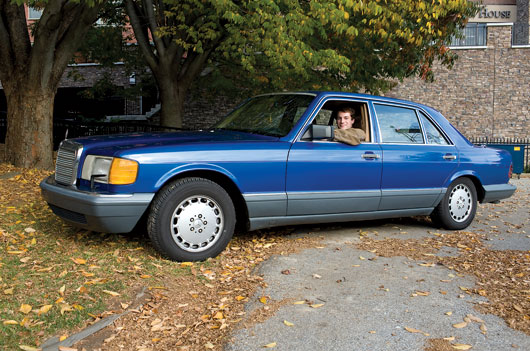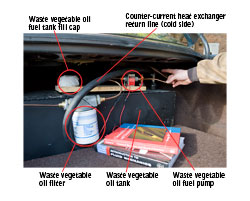Out of the frying pan, into the car

ON THE GREEN | Colin Sweeney is used to hearing one particular question when he tells people about his car: “Does it smell like French fries?”
He drives a 1986 Mercedes SDL, which he has converted to run on cooking oil. His answer? “No, it actually smells kind of sweet.”
A junior chemical engineering major, Sweeney commutes to campus from Townsend, Del., every day, a 60-mile round trip. The price of gas motivated him to initiate the project, he says, but it was his passion for working on engines and his knowledge of fluid mechanics and heat transfer that enabled him to carry it out.

“I found kits that you can buy to convert a car to run on cooking oil, but they seemed overly complicated mechanically and at the same time overly simplistic for the user,” he says. “I decided to design my own so that I would have control over every aspect. If there was a problem, I wanted to be able to look at the gauges and know immediately what was wrong.”
Sweeney got off to a rough start. He purchased the car, which has a 3-liter turbo-charged diesel engine, during his freshman year at what he thought was a bargain-basement price. He soon learned that the engine had a blown head gasket.
Once that was fixed, he turned his attention to the conversion process. The trunk of the car is now outfitted with a 20-gallon tank for the oil, matching the capacity of the existing diesel tank. Using both sources of fuel, the car has a range of about 1,100 miles.
When it is first started, the Mercedes runs on diesel fuel, as the cooking oil has to reach a temperature of about 120 degrees Fahrenheit before it can power the engine. Sweeney’s system employs counter-current heat exchangers so that the coolant from the engine can be used to heat the oil.
“The biggest challenge is to heat the oil as rapidly as possible,” he says.
Although most people who convert their vehicles get the used cooking oil from restaurants that have used it for frying and would then throw it away, Sweeney obtains his fuel from the discards of a processing plant that tests cooking oil.
The project has not only saved him money but also contributed to his education.
“Colin got hands-on lessons about fluid flow and heat transfer, before even taking these junior level courses,” says Annette Shine, associate professor of chemical engineering.
“Designing the system was easy,” he says. “Building it was another story.”
But for Sweeney, who has been working on cars and engines since he was in middle school, the project was well worth the time he put into it. “It’s a pretty crude estimate at this point, but I think I can get about 100 miles to the gallon,” he says.
A new coat of bright blue paint lets the Mercedes hide its age well. With 375,000 miles on its odometer, the vehicle is three years older than its owner.
Article by Diane Kukich, AS ’73, ’84M





